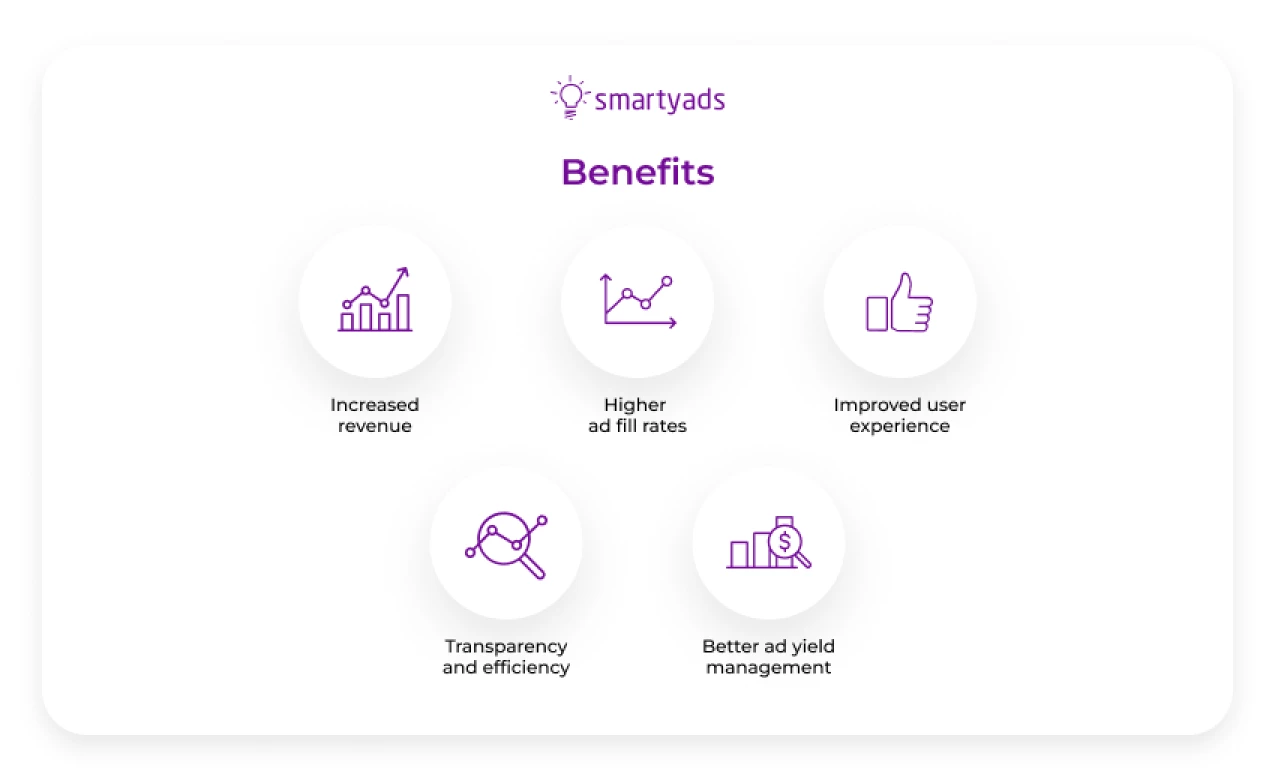Video header bidding has emerged as a powerful instrument in the realm of digital advertising that can help publishers maximize their revenue, and improve viewers’ experiences. In case you are not sure what it is and how it works, you have landed in the right place.
Today’s article is an extensive guide and down below, you will find everything you should know about this game-changer: video header bidding meaning, its importance in digital advertising, how it works as well as top best practices that will help you get the most out of it.

Overview of video header bidding
As video advertising has gained significant popularity and its importance in digital advertising keeps growing at a steady pace, you should know about the most sophisticated technology related — header bidding for video.
What is header bidding?
Before we move to the video header bidding definition, let’s define what header bidding is.
Header bidding is an advanced technique of trading inventory in programmatic advertising. It implies publishers receive bids from different advertisers simultaneously rather than one by one.
This unified method significantly speeds up all the processes and optimizes the publisher’s revenue. As it creates higher competition among the advertisers, it will result in a higher CPM for a publisher.
What is video header bidding?
Now, as you know what the essence of this technology is, cracking the video header bidding meaning won’t be a problem.
Video header bidding is the same as header bidding — an advanced technology implemented in video advertising. Unlike traditional waterfall methods, where bids are placed sequentially, it enables multiple demand sources (advertisers) to bid on a video ad inventory simultaneously. It leads to higher bids, thus, increasing the publisher’s revenue.
Why is video header bidding important?

This technique is an indispensable part of the video advertising strategy of many businesses. But why does it matter?
- Increased revenue. Advertisers get more competitive which results in higher CPM and revenue for publishers.
- Higher ad fill rates. Having multiple bidders will increase your chances to fill video inventory, meaning improved fill rates.
- Improved user experience. It can result in faster load time which provides a smooth experience for the users.
- Transparency and efficiency. It is a more transparent auction process compared to traditional waterfall approaches.
- Better ad yield management. It allows real-time adjustments and setting floor prices based on demand which can optimize ad yield.
How does video header bidding work?
There are two types of header bidding in video advertising: client-side and server-side video.
- Client-side video header bidding
In this case, when a user enters a page, the video player starts loading which triggers the video header bidding process. Then, SSPs will send requests to various DSPs and ad exchanges, which place bids on available video inventory.
When it’s done, SSPs will collect the bids and forward them to the header bidding wrapper which will evaluate these bids to determine the highest one and send the winner to the publisher’s ad server. The ad server will compare the highest bids from different sources (e.g. private marketplace deals) and then serve the winner to the video player so that users can view the advertisement.
- Server-side video header bidding
Here, the video player also starts loading. Then, the header bidding wrapper will send the requests to the server-side vendor. In their turn, the vendor forwards the requests to different SSPs (which send requests to various DSPs) at the same time.
After this, the SSPs will send the highest bids to the server-side vendor which will send the winning bids to the header bidding wrapper. Then the bid request will be sent to the ad server. When all the highest bids are compared with private marketplaces, the one winning bid will be selected to demonstrate the ad in the video player.

5 best practices for video header bidding from SmartyAds team
Now, let’s take a look at the best practices so you can understand how to get your video header bidding example process right.
Advanced server-side integration
By integrating server-side video header bidding, the ad latency can drop down and you will easily improve user experience. Based on our experience, this way publishers can attain faster ad delivery and cut down time needed to load pages. Such a simple step can take the viewer's experience to a whole new level, and achieve higher bid responses, which will eventually lead you to better revenue.
Machine learning and AI
In the era when machine learning and AI are ruling this world, leveraging these technologies is also crucial. They can effectively optimize bid strategies. Machine learning algorithms can process vast amounts of data to make predictions for the best ad placements. It can also analyze viewer behavior and preferences so you can come up with more targeted and effective bidding.
Compliance with industry standards
It’s recommended to adhere to the main video advertising standards such as VAST (video ad serving template) and VPAID (video player-ad interface definition). It can ensure compatibility with different ad networks and video players, facilitating smoother integration and mitigating potential technical problems.
Compliance will also grant better transparency and nurture trust among partners and stakeholders, paramount for building long-term partnerships and maximizing revenue potential.
Optimizing floor prices
It’s important to set appropriate floor prices. This tactic is essential for maximizing revenue without scaring away potential bidders. It will attract only highly competitive advertisers that will generate bigger earnings.
We recommend constantly reviewing your performance and adjusting your floor prices based on it as well as market demand.
Regular performance monitoring
Continuous performance analysis is an indispensable part of any publisher’s activity. If you want your video header bidding performance to skyrocket, it’s imperative to use advanced analytics tools to measure key metrics such as ad fill rates and CPMs.
Regular performance tracking can help you identify areas for improvement and ensure maximum efficiency of your efforts. This proactive approach also allows publishers to effectively optimize their activities and make data-driven decisions to boost revenue.
How can SmartyAds help?
SmartyAds has years of experience in the field of programmatic advertising. Based on our extensive expertise, our team has developed a feature-rich and convenient SSP that offers unparalleled opportunities for publishers to elevate their advertising game and generate bigger revenue.
This agile supply-side platform is one of the most effective and intuitive video ad exchanges that also enables publishers to work with other different types of ad inventory. This programmatic tool has all the necessary features publishers might need to effectively allocate, manage, and monetize their inventory, connect with premium publishers, and easily track their performance to optimize it and ensure the highest yield.
Get full transparency and complete control over your inventory at all levels. It’s time to sell your ad space to premium clients, monetize unsold inventory, and enjoy competitive pricing.
Get started with SmartyAds SSP — maximize your video ad inventory revenue today!





